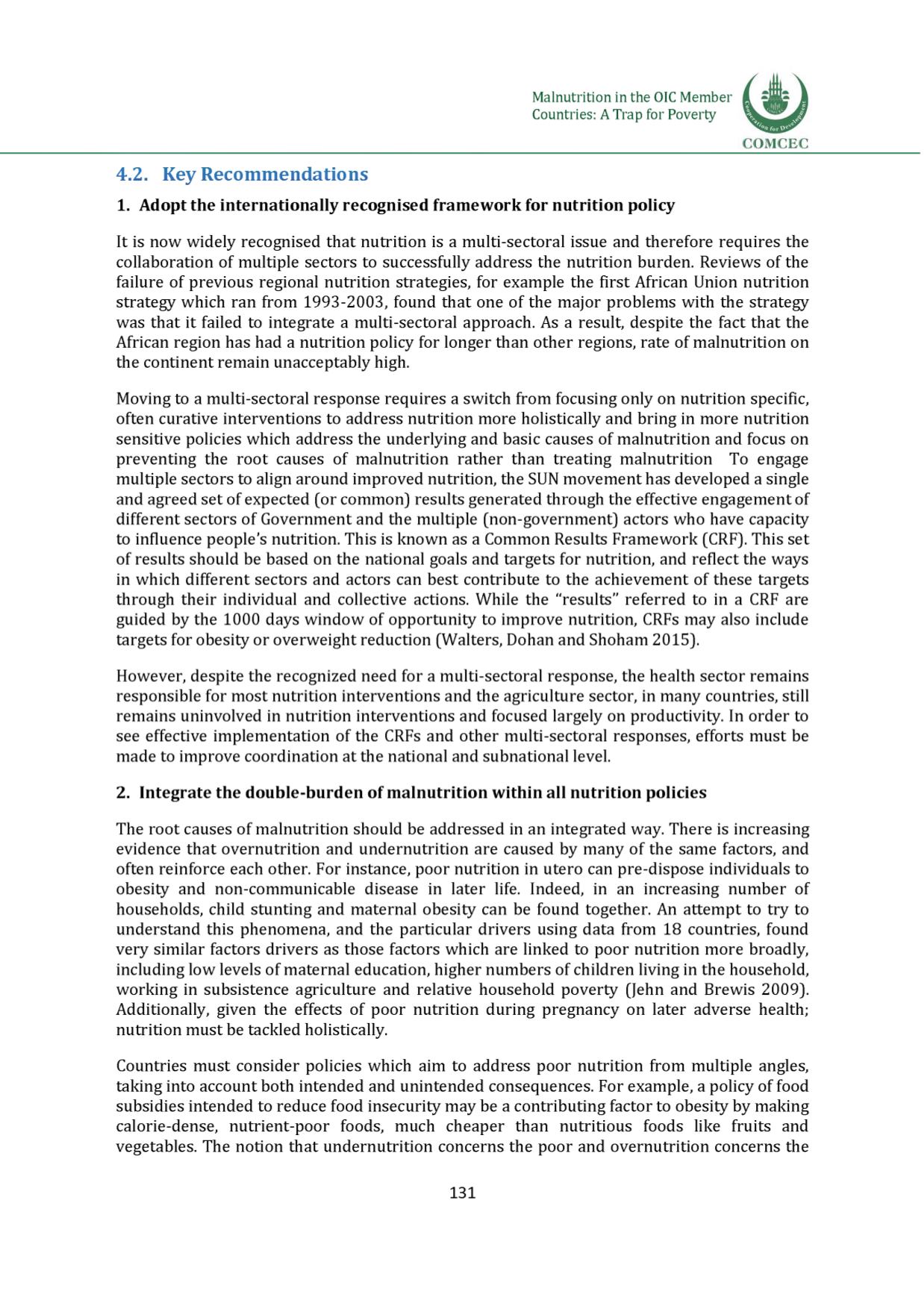

Malnutrition in the OIC Member
Countries: A Trap for Poverty
4 .2 . Key Recommendations
1. Adopt the internationally recognised framework for nutrition policy
It is now widely recognised that nutrition is a multi-sectoral issue and therefore requires the
collaboration of multiple sectors to successfully address the nutrition burden. Reviews of the
failure of previous regional nutrition strategies, for example the first African Union nutrition
strategy which ran from 1993-2003, found that one of the major problems with the strategy
was that it failed to integrate a multi-sectoral approach. As a result, despite the fact that the
African region has had a nutrition policy for longer than other regions, rate of malnutrition on
the continent remain unacceptably high.
Moving to a multi-sectoral response requires a switch from focusing only on nutrition specific,
often curative interventions to address nutrition more holistically and bring in more nutrition
sensitive policies which address the underlying and basic causes of malnutrition and focus on
preventing the root causes of malnutrition rather than treating malnutrition To engage
multiple sectors to align around improved nutrition, the SUNmovement has developed a single
and agreed set of expected (or common) results generated through the effective engagement of
different sectors of Government and the multiple (non-government) actors who have capacity
to influence people's nutrition. This is known as a Common Results Framework (CRF). This set
of results should be based on the national goals and targets for nutrition, and reflect the ways
in which different sectors and actors can best contribute to the achievement of these targets
through their individual and collective actions. While the “results” referred to in a CRF are
guided by the 1000 days window of opportunity to improve nutrition, CRFs may also include
targets for obesity or overweight reduction (Walters, Dohan and Shoham 2015).
However, despite the recognized need for a multi-sectoral response, the health sector remains
responsible for most nutrition interventions and the agriculture sector, in many countries, still
remains uninvolved in nutrition interventions and focused largely on productivity. In order to
see effective implementation of the CRFs and other multi-sectoral responses, efforts must be
made to improve coordination at the national and subnational level.
2. Integrate the double-burden of malnutrition within all nutrition policies
The root causes of malnutrition should be addressed in an integrated way. There is increasing
evidence that overnutrition and undernutrition are caused by many of the same factors, and
often reinforce each other. For instance, poor nutrition in utero can pre-dispose individuals to
obesity and non-communicable disease in later life. Indeed, in an increasing number of
households, child stunting and maternal obesity can be found together. An attempt to try to
understand this phenomena, and the particular drivers using data from 18 countries, found
very similar factors drivers as those factors which are linked to poor nutrition more broadly,
including low levels of maternal education, higher numbers of children living in the household,
working in subsistence agriculture and relative household poverty (Jehn and Brewis 2009).
Additionally, given the effects of poor nutrition during pregnancy on later adverse health;
nutrition must be tackled holistically.
Countries must consider policies which aim to address poor nutrition from multiple angles,
taking into account both intended and unintended consequences. For example, a policy of food
subsidies intended to reduce food insecurity may be a contributing factor to obesity by making
calorie-dense, nutrient-poor foods, much cheaper than nutritious foods like fruits and
vegetables. The notion that undernutrition concerns the poor and overnutrition concerns the
131
















